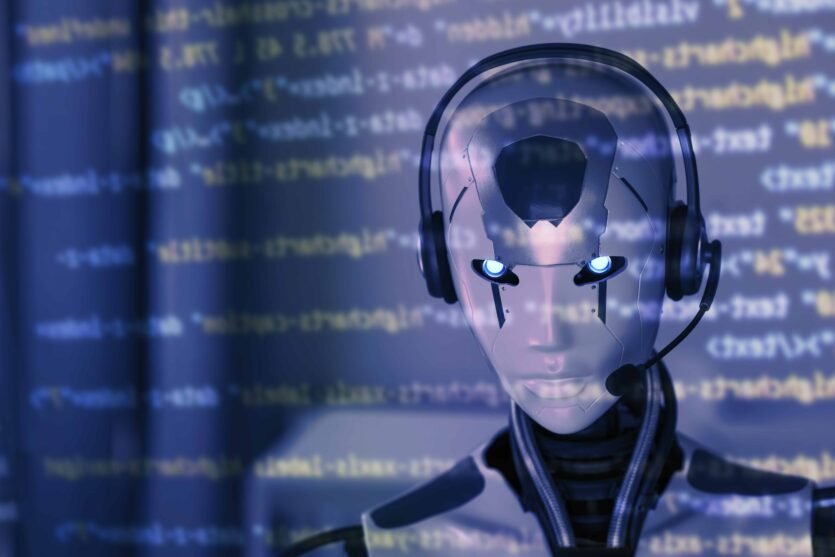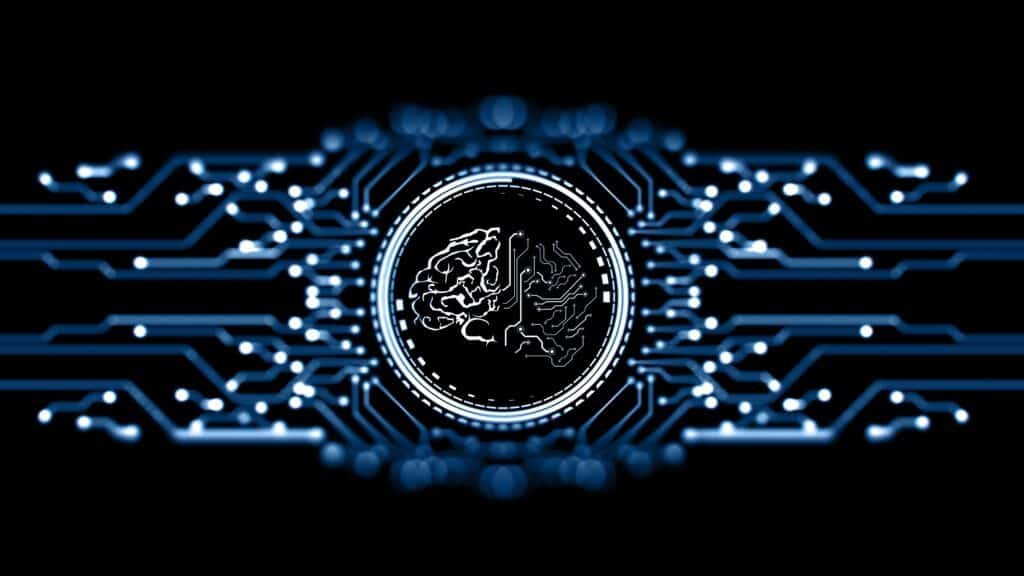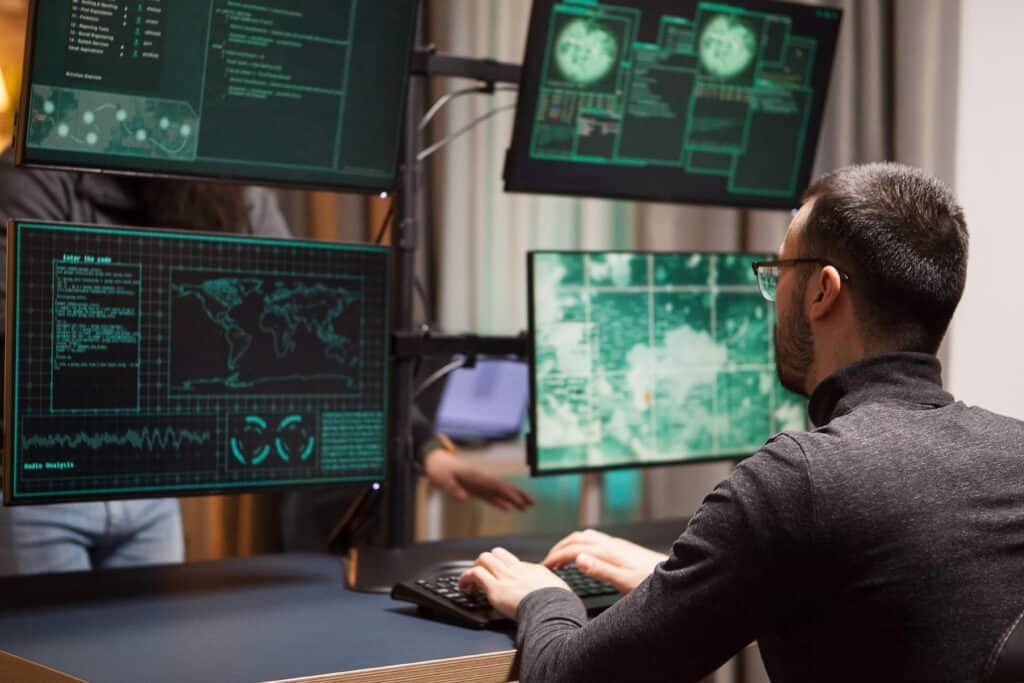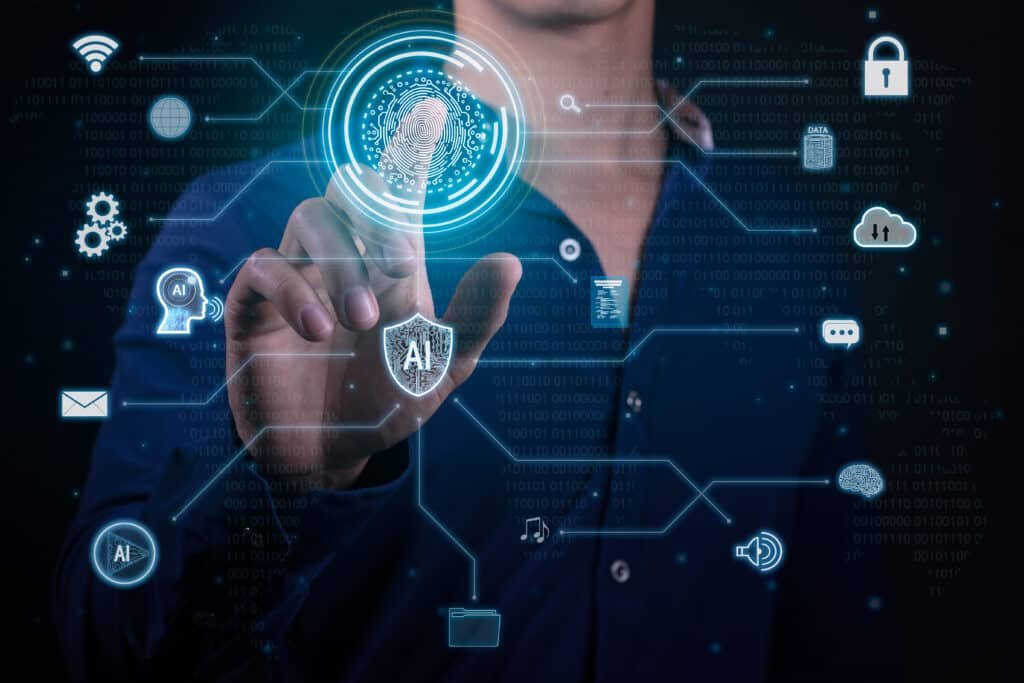The Risks of AI Powered Cyber Attacks in 2023

We may earn a small fee from the companies mentioned in this post.
As artificial intelligence (AI) continues to revolutionise various industries, it also poses new risks and challenges in the realm of cybersecurity. The potential of AI powered cyber attacks has grown exponentially, raising concerns for businesses and governments alike.
With the capabilities of AI advancing at an unprecedented pace, staying informed, and prepared, is more crucial than ever. This blog post will delve into the growing threat of AI powered cyber attacks, real-world examples, and strategies to defend against these emerging cybersecurity threats.
Short Summary – AI Powered Cyber Attacks
AI powered cyber attacks are increasingly destructive and difficult to detect.
Organisations must strengthen their security infrastructure, implement AI defence solutions, and foster collaboration among stakeholders in order to defend against these threats.
Natural language processing has enabled the creation of more effective phishing emails that organizations need to be aware of in order to protect sensitive information.
The Growing Threat of AI-Powered Cyber Attacks

The increasing risk posed by AI powered cyber attacks highlights the need for organizations to be aware of the potential consequences, such as big data, theft, infrastructure disruption, and deep fake content. Artificial intelligence technologies can facilitate faster threat detection, threat identification, and threat response for security teams.
However, the potential of AI powered systems to learn and adapt has the capacity to bring about a new era of highly sophisticated, tailored, and human-like attacks.
Generative AI techniques, for instance, can be utilised to enhance malicious exploits and create more complex cyberattacks. AI powered attacks can be more destructive and challenging to detect than traditional cyber attacks due to their capability to quickly analyse millions all possible attack vectors, select the most effective option, execute successfully, and evade detection, while adapting and evolving in real time.
As the landscape of cyber threats evolves, it is crucial for organisations to stay informed and prepared, constantly adapting their security infrastructure to counter these emerging threats. This includes understanding the role of machine learning in both enhancing cybersecurity measures and enabling cybercriminals to further exploit vulnerabilities and carry out advanced attacks.
Sophisticated and Targeted AI Powered Cyber Attacks
Sophisticated and targeted attacks are becoming increasingly common as AI technology advances, making security professionals say it essential for organisations to remain knowledgeable and prepared.
Cybercriminals leverage AI-driven techniques, such as end-to-end spear-phishing, which is a highly automated method of identifying high-priority targets and disseminating personalized machine-generated information.
Automated domain generation, another AI-driven technique, utilises domain generation algorithms (DGAs) to execute sophisticated cyber attacks in the command and control phase of the cyber security kill chain.
As AI continues to advance, organisations must be proactive in their cyber security efforts to detect and mitigate the effects of these increasingly sophisticated attacks.
The Role of Machine Learning
Machine learning (ML) plays a significant role in both enhancing cybersecurity measures and enabling cybercriminals to carry out advanced attacks. Malicious actors can generate AI-powered malware, or harness AI techniques to execute attacks in the cybersecurity kill chain, using a variety of algorithms such as Convolutional Neural Network (CNN), Generative Adversarial Network (GAN), and Recurrent Neural Network (RNN).
One example of an AI-driven malware is DeepHack, a machine and deep learning and model that utilises neural networks and reinforcement learning to break and bypass web-based applications. As AI and ML technologies advance, understanding their role in cyber attacks becomes crucial for organizations to protect their assets and information.
Real-World Examples of AI Powered Cyber Attacks

Real-world examples of AI powered cyber attacks demonstrate the potential dangers and consequences of these threats. NotPetya, BlackEnergy, and AI generated deep fakes are some examples of AI powered cyber attacks. NotPetya utilised an AI powered algorithm that enabled it to spread worms swiftly, without being detected by antiviruses. This resulted in a successful infection of multiple computers. This attack resulted in billions of dollars in damages to businesses across the globe.
Another example is a hacker who defrauded a UK energy firm by utilising AI to simulate the CEO’s voice in a telephone call. AI powered bots were also utilised during the 2016 US presidential election to flood social media with fake news stories, propaganda, and other misleading content to obfuscate the facts or simply complicate discussions.
These real-world examples underscore the importance of understanding and preparing for the potential risks associated with AI powered cyber attacks.
Defending Against AI Powered Cyber Attacks

Defending against AI-driven cyber threats requires a multi-pronged approach, including strengthening security infrastructure, implementing AI-powered defence solutions, and fostering collaboration among stakeholders.
Incorporating AI-focused cybersecurity personnel, evaluating AIOps platforms, and augmenting security awareness training are all strategies that can be employed to bolster security infrastructure.
AI can also be utilised to avert cyberattacks through the examination of network activity and the identification of abnormalities or security events that are not normal. Additionally, edge security solutions tailored for edge networks can be adopted to defend against adversarial AI attacks.
Collaboration among stakeholders is critical for warding off AI-driven cyber threats, entailing exchanging information regarding threats, establishing best practices, and collaborating to devise solutions.
Strengthening Security Infrastructure
Forming a comprehensive view of security and infrastructure necessitates grasping the existing security position, recognising potential risks, and constructing a strategy to counter those risks. Implementing access controls requires establishing authentication and authorisation protocols, monitoring user access, and periodically reviewing access privileges.
Strong authentication methods, such as two-factor authentication, can be implemented, and access control lists can be utilised to ensure access is granted only to those individuals who require it.
To secure assets and perform a comprehensive risk assessment, organisations should identify and prioritize their assets, evaluate the risks tied to each asset, and devise a plan to mitigate those risks. Implementing encryption algorithms, encrypting data at rest and in transit, and utilising secure protocols are suggested approaches for encrypting sensitive data.
Conducting regular security audits entails evaluating the security posture of the system, pinpointing potential vulnerabilities, and instituting measures to address those vulnerabilities. By continuously assessing and adapting their security infrastructure, organisations can better protect themselves against advanced persistent threats and other emerging cyber risks.
AI Powered Defence Solutions
AI-powered defence solutions can quickly detect and respond to threats far more effectively than traditional software-driven approaches. This can result in improved cyber security for organisations. AI is a powerful tool for analysing and spotting threats, even if they are rare or new. It can continuously learn from incoming events and realize the difference between acceptable behaviour and concerning patterns.
Furthermore, with the capacity to consume billions of data artifacts, AI enhances its knowledge to “comprehend” cybersecurity threats and risks and analyze correlations between them, assisting in detecting attacks more precisely and prioritizing responses based on real-world and risk data.
Effective AI-powered defense solutions can include intrusion detection systems, threat intelligence platforms, and security information and event management systems. These AI systems can help detect and respond to cyber threats in a timely manner, allowing organisations to better manage their attack surface and prioritize their responses.
As AI and ML technologies continue to advance, harnessing their potential for threat detection and response becomes increasingly important. By integrating AI powered defense solutions into their security infrastructure, organizations can better protect themselves against the growing threat of AI-driven cyber attacks.
Checkout our informative blog on – what a cyber attack means
Collaborative Efforts
Collaboration between governments, organizations, and cyber security professionals is critical for devising and executing effective measures to counter AI-driven cyber attacks. Collaborative efforts in cybersecurity can facilitate quicker detection and response to threats, as well as the exchange of experience and resources among different organizations. This can result in a more comprehensive and efficient defense against cyber threats.
By fostering collaboration among stakeholders, organisations can stay ahead of the curve in the rapidly evolving landscape of AI powered cyber attacks. Sharing information and best practices, as well as working together to develop innovative solutions, can significantly improve the overall effectiveness of cyber security efforts.
Checkout our informative article on ‘7 types of cyber security threats’
The Role of Natural Language Processing in Phishing Attacks

Natural language processing is employed in phishing attacks to generate tailored and convincing phishing emails and messages directed at high-value targets. DeepPhish is an AI algorithm that uses effective past phishing URLs to create synthetic ones. It serves as an example of such an algorithm. The attack’s efficacy rate was increased from 0.69% to 20.9% and from 4.91% to 36.28% after training DeepPhish on two different threat actors.
This highlights the potential for AI generated phishing emails and other social engineering tactics to become more effective and harder to detect. Organisations need to be cognisant of the role of natural language processing in phishing attacks and take appropriate measures to safeguard their sensitive information from these increasingly sophisticated threats.
Check out our informative article on what is Smishing
Preparing for Advanced Persistent Threats

Advanced persistent threats (APTs) are highly developed and aimed cyber attacks that seek to gain access to a system or network and remain undetected for an extended period of time. In order to protect against APTs, it is recommended to limit access to devices, enforce strong access control for users, secure assets, conduct a thorough risk assessment, and deploy network and endpoint protection tools to identify and alert administrators to any unusual activity or indicators of an APT attack.
Understanding the evolving nature of cyber attacks and implementing robust cyber security measures are essential for organisations to protect against advanced persistent threats. By staying informed and prepared, organisations can better defend their assets and information from the growing threat of AI powered cyber attacks.
The Future of AI and Cybersecurity: Opportunities and Challenges

The future of AI and cybersecurity presents both opportunities and challenges. AI can be employed to enhance the accuracy and effectiveness of threat detection and response, as well as to automate mundane tasks, allowing security personnel to concentrate on more intricate tasks. However, the use of AI by malicious actors can lead to the development of more sophisticated cyber threats, while automated malicious activities enabled by AI can make it difficult to detect and respond to threats.
There are ethical considerations to be taken into account when utilizing AI in cyber security, such as the potential for AI to be leveraged to target vulnerable populations or to infringe upon privacy. As AI technology continues to advance, it is crucial for organisations to stay informed and prepared, balancing the opportunities and challenges presented by AI in the cyber security domain.
The Security Operations Center in the Age of AI

The role of the security operations centre (SOC) in the age of AI is to monitor and safeguard an organisation’s assets. AI can augment the abilities of the SOC by automating processes and supplementing the efforts of security personnel to address threats. AI-powered tools and strategies can facilitate the detection of cyber threats with increased speed and accuracy, enable a deeper analysis, automate threat detection and enhance the efficacy of responses.
However, the challenges associated with integrating AI-powered tools and strategies into the security operations center include the requirement for specialized personnel, the expense of implementation, and the possibility of bias in the algorithms.
In the age of AI, it is essential for security operations centers to adapt to the changing threat landscape and leverage AI-powered tools and strategies to detect, analyse, and respond to cyber threats more effectively.
Summary
The rise of AI powered cyber attacks underscores the importance of staying informed and prepared in the ever-evolving landscape of cybersecurity. By understanding the growing threat of AI-driven cyber attacks, exploring real-world examples, and implementing robust security measures, organisations can better safeguard their assets and information from these emerging threats.
As we continue to navigate the opportunities and challenges presented by AI in cybersecurity, it is crucial for organisations to adapt and evolve their security strategies in order to stay one step ahead of malicious actors.
Frequently Asked Questions
What are AI powered cyber attacks?
AI powered cyberattacks are malicious acts that use sophisticated artificial intelligence tools to target individuals or organisations. These attacks are difficult to detect and can lead to serious consequences such as financial loss, identity theft, and disruption of critical infrastructure.
As these techniques become increasingly powerful and prevalent, it is important to take measures to avoid detection and protect against them.
What is an example of AI powered cyber security?
AI powered cyber security is the use of artificial intelligence and machine learning to identify, prevent, and respond to potential threats. This includes detecting malicious activities such as malware and phishing, consolidating knowledge about potential attacks, and prioritising new threats in order to protect networks and data.
How AI is used in cybercrime?
AI has enabled cybercriminals to more easily launch powerful and complex attacks. AI-driven bots are used to automate phishing campaigns, making it easier to target large numbers of people with highly personalised messages.
In this way, AI is being used to facilitate many types of cybercrime.
How can AI be used to enhance cybersecurity measures?
AI can be used to help automate the detection of malicious activity and bolster security defences against malicious actors, making it easier to detect suspicious activities.
AI driven cybersecurity solutions are increasingly being utilized to strengthen network defence systems and detect malicious activities in real-time, helping to enhance the overall security posture. Additionally, AI can be used to automate many security processes, freeing up resources for more complex tasks.
What role does machine learning play in cyber attacks?
Through these machine learning techniques, cyber attackers can more effectively recognize patterns and create algorithms that are designed to identify potential vulnerabilities in computer systems and networks. This capability makes it easier for malicious actors to exploit those weaknesses for malicious purposes.
Useful external information
- How AI Is Useful and Not Useful — for Cybersecurity (darkreading.com)
- Using Artificial Intelligence in Cybersecurity
- Artificial Intelligence and Cybersecurity Research — ENISA (europa.eu)
With over three decades of experience in the heart of London’s financial sector, I have dedicated my career to the pursuit of robust cybersecurity practices and IT leadership. As a Certified Information Systems Security Professional (CISSP), Certified Information Security Manager (CISM), Certified Chief Information Security Officer (C|CISO), Certified Ethical Hacker (CEH), and Computer Hacking Forensic Investigator (CHFI), I bring a wealth of knowledge and expertise to the table.
My journey in the field of cybersecurity has not only been about personal growth but also about sharing my insights with others. As an international speaker, I have had the privilege of addressing audiences worldwide, discussing the importance of cybersecurity in today’s digital age. My passion for knowledge sharing extends to my work as an author and blogger, where I delve into the complexities of cybersecurity, offering practical advice and thought leadership.
In my role as a CISO and Head of IT, I have overseen the development and implementation of comprehensive information security and IT strategies. My focus has always been on creating resilient systems capable of withstanding the evolving landscape of cyber threats.
My Master’s degree in Cybersecurity has provided a solid academic foundation, which, when combined with my practical experience, allows me to approach cybersecurity from a holistic perspective.
I am always open to connecting with other professionals in the field, sharing knowledge, and exploring new opportunities. Let’s secure the digital world together.

